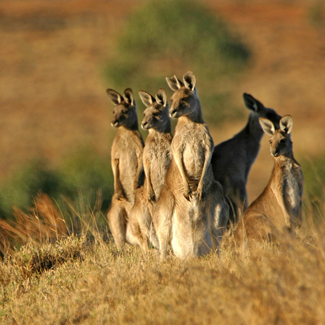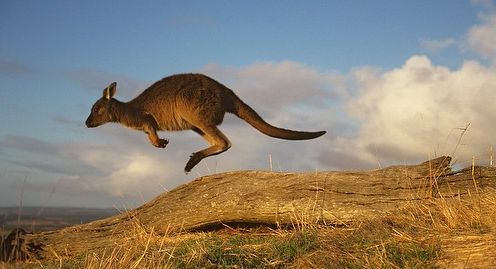NRIA advocates kangaroo for ‘bushmeat’
Friday, December 31st, 2010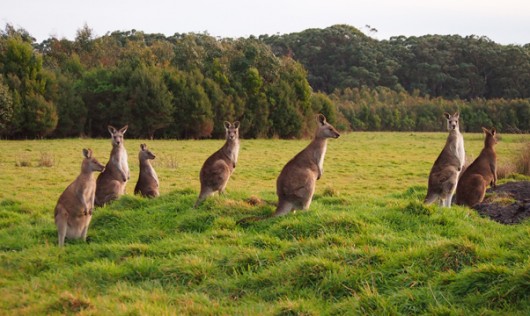 Eastern Grey Kangaroos
(Australian Geographic)
Eastern Grey Kangaroos
(Australian Geographic).
New Rural Industries Association
.
A new rural organisation in Australia, driving innovative agribusiness ideas, the New Rural Industries Association (NRIA) truly has some good ideas for those on the land. But one of them is certainly not such a good idea – supporting more kangaroo slaughter.
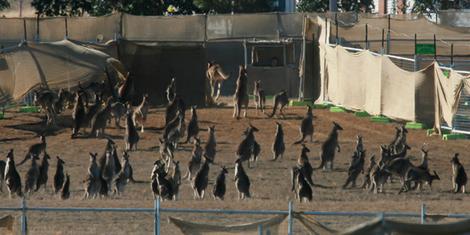 Kangaroos around Canberra herded into pens for the slaughter
.. then butchered for packaging into cat and dog food
Photo by Andrew Taylor
[Source: ^http://www.smh.com.au/news/conservation/welfare-groups-outraged-as-kangaroo-cull-starts/2008/05/19/1211182703329.html]
Kangaroos around Canberra herded into pens for the slaughter
.. then butchered for packaging into cat and dog food
Photo by Andrew Taylor
[Source: ^http://www.smh.com.au/news/conservation/welfare-groups-outraged-as-kangaroo-cull-starts/2008/05/19/1211182703329.html]
.
The NRIA on its new website states that its mission is:
“through cooperation, coordination and education, to create an environment for the development and capacity-building of new, innovative, Australian rural industries and to maximise the economic benefits our nation gains from such industries.” .At what ecological cost? At what untold wildlife trauma?
.
It is all very well encouraging those on the land to make a quid and prosper from new emerging agricultural markets, but poaching wildlife is immoral in the mix of available options.
To push for more wildlife trade in Australia, is akin to the logging industry pushing for a new exploitative use of our native forests for ‘biomass’ – burning trees for power! It is no different to the ‘bushmeat’ wildlife trade currently being prosecuted from Africa to Europe.
Reading the NRIA website section under New Animal Industries – ‘Kangaroos and Wallabies‘- the script seems taken drirectly out of a promotion by the Kangaroo Industry Association (KIA). It is peppered with exploitative euphemistic terms like ‘kangaroo industry‘, ‘kangaroo harvesting‘ and ‘pest control‘. All terms deliberately chosen to try to legitimise what is blatantly wildlife poaching.
Then it suggests that the poaching is legitimate by claiming there is “a quota system” and that the poaching is “administered by the state and federal governments”.
It then argues that this wildlife trade is highly lucrative, quoting the “kangaroo industry was an estimated $43.9 million in 2007”, with major export markets being Indonesia, New Zealand and Russia. It is trying to sell kangaroo meat overseas beyond what has long been regarded as pet food. It is trying to rebrand the pet food as ‘game meat’ and is having success in Europe, notably recently in France, South Africa and Germany, and in Russia as sausage meat..
.
‘Bushmeat’?
.
Wildlife is wildlife and with so little remaining on so few token reserves, all wildlife deserve humanity’s utmost respect and protection.
Australian wildlife is no less deserving than African wildlife. In Africa, ‘illegal bushmeat is being sold on Paris streets‘ ranging from monkey carcasses, smoked anteater, even preserved porcupine. In Australian, bushmeat is our wildlife – our native kangaroo, wallaby, koalas, platypus, echidna, Tasy devil, wombat, potoroo and many other unique and vulnerable fauna.
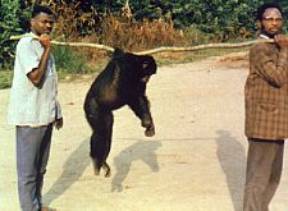 ‘A bonobo, most human-like of the great apes, killed for meat’.
‘A bonobo, most human-like of the great apes, killed for meat’.
© SUSAN MILIUS / Science News 26feb2005
http://www.mindfully.org/Food/2005/Bushmeat-Hunger-Commerce26feb05.htm.
‘In Paris, a recent study has found more than five tonnes of bushmeat slips through the city’s main airport each week to serve its underground bushmeat market. Experts suspect similar amounts are arriving in other European hubs as well – an illegal trade that is raising concerns about diseases ranging from monkeypox to Ebola, and is another twist in the continent’s struggle to integrate a growing African immigrant population. According to research published in the journal ‘Conservation Letters’,
“Anecdotally we know it does happen … But it is quite surprising the volumes that are coming through,” said Marcus Rowcliffe, a research fellow of the Zoological Society of London and one of the study’s authors.
“Everyone knows bushmeat is sold in the area and they even know where to buy it,” said Hassan Kaouti, a local butcher. “But they won’t say it’s illegal.”
For the study, European experts checked 29 Air France flights from Central and West Africa that landed at Paris’ Roissy-Charles de Gaulle airport over a 17-day stretch in June 2008. Of 134 people searched, nine had bushmeat and 83 had livestock or fish.
The people with bushmeat had the largest amounts: one passenger had 51kg of bushmeat – and no other luggage. Most of the bushmeat was smoked and arrived as dried carcasses. Some animals were identifiable, though scientists boiled the remains of others and reassembled the skeletons to determine the species.
Experts found 11 types of bushmeat including monkeys, large rats, crocodiles, small antelopes and pangolins, or anteaters. Almost 40 per cent were listed on the Convention on International Trade in Endangered Species.
Based on what officials seized – 188kg of bushmeat – the researchers estimated that about five tonnes of bushmeat get into Paris each week.
Bushmeat is widely eaten and sold in Central and West Africa, with Central African Republic, Cameroon and Republic of Congo being the main sources. It varies whether it is legal. It is typically allowed where people are permitted to hunt, as long as their prey aren’t endangered and they can prove the animals were killed in the wild. And just as scientists have warned that eating African bushmeat is a potential health hazard, eating roadkill and wildlife is just at risk of bacterial infections like salmonella and ecoli.
Nina Marano, chief of the quarantine unit at the US Centres for Disease Control and Prevention, said similar underground markets for bushmeat exist across the US. “We have to be culturally sensitive and recognise this is important for some African communities,” she said. “But there are no regulations for the preparation of meat from wildlife to render it safe.”
The scale of Europe’s illicit bushmeat trade suggests the emergence of a luxury market. Prices can be as high as 30 euros ($A43) per kilogram, double what more mundane supermarket meats cost. “It’s like buying the best cut of organically grown beef,” Rowcliffe said, adding that bushmeat like giant rats and porcupine, which he has tasted, has a strong, gamey flavour.’
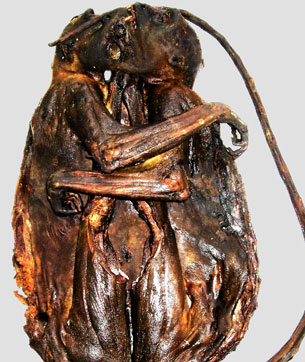 © AP, [Source: ‘Illegal bushmeat sold on Paris streets’, AP, The West Australian,20100618,
http://au.news.yahoo.com/odd/a/-/odd/7419656/illegal-bushmeat-sold-on-paris-streets/]
© AP, [Source: ‘Illegal bushmeat sold on Paris streets’, AP, The West Australian,20100618,
http://au.news.yahoo.com/odd/a/-/odd/7419656/illegal-bushmeat-sold-on-paris-streets/]
.
Meanwhile back in Australia, the NRIA claims “commercial harvesting” of wallabies is happening across Tasmania and on Flinders Island and King Island in Bass Strait…”ensuring the sustainability of the harvest“. Shooters are now targeting Tasmania’s beautiful Bennett’s Wallaby (Macropus r. rufogriseus) and the Tasmanian Pademelon (Thylogale billardierii).
.
“More than 9000 wallabies were harvested in 2005-06 but this was much less than the combined quota of 34,750.”
.
Wildlife slaughter and trade is unnecessarily wicked!
.
Why is Australia’s Gillard Government condoning a trade in Australian wildlife?
.
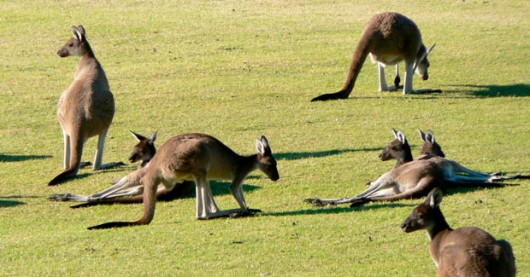 Eastern Grey Kangaroos
Kangaroos are commonly killed to save crops and private property
(Photo by Michael Parsons)
[Source: Australian Geographic magazine, ^http://www.australiangeographic.com.au/journal/dingo-urine-saves-kangaroos-study-says.htm]
Eastern Grey Kangaroos
Kangaroos are commonly killed to save crops and private property
(Photo by Michael Parsons)
[Source: Australian Geographic magazine, ^http://www.australiangeographic.com.au/journal/dingo-urine-saves-kangaroos-study-says.htm]
.
.
Further Reading
.
[1] Kangaroo Industry Association of Australia (^http://www.kangaroo-industry.asn.au).
[2] Australian Department of Environment and Water Resources, ^www.environment.gov.au/biodiversity/trade-use/wild-harvest/kangaroo/stats.html, (for information on the kangaroo industry, including quotas and numbers harvested).
[3] New Rural Industries Australia ^http://www.nria.org.au/NewAnimalIndustries/KangaroosandWallabies.aspx ]
[4] ‘Illegal bushmeat sold on Paris streets’, AP, The West Australian, 20100618, ^http://au.news.yahoo.com/odd/a/-/odd/7419656/illegal-bushmeat-sold-on-paris-streets/]
[5] ‘Illegal Bushmeat Trade Rife in Europe, Research Finds’, ScienceDaily (June 18, 2010), ^http://www.sciencedaily.com/releases/2010/06/100617210641.htm
[6] Kangaroo Protection Coalition, ^http://www.kangaroo-protection-coalition.com/canberrakangaroocull.html
[7] AQIS Meat Notice 2010/02 – Microbiological Testing of Wild Game Carcases and Products ^http://www.daff.gov.au/aqis/export/meat/elmer-3/notices/meat_notices_2010/2010-02_microbiological_testing_of_wild_game_carcases_and_products
.
-end of article –
